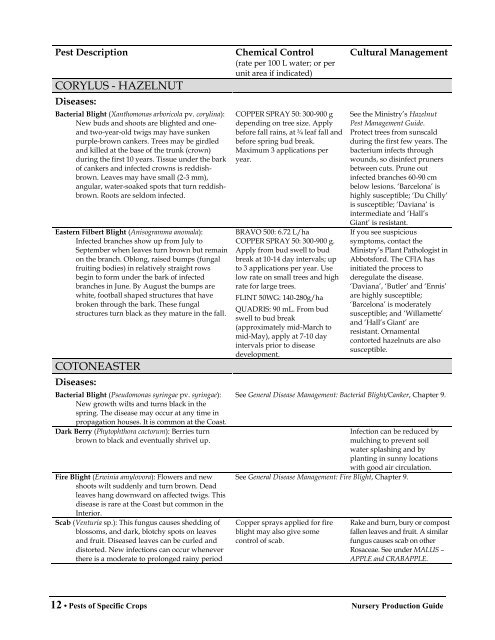You also want an ePaper? Increase the reach of your titles
YUMPU automatically turns print PDFs into web optimized ePapers that Google loves.
Pest Description<br />
CORYLUS - HAZELNUT<br />
Diseases:<br />
Bacterial Blight (Xanthomonas arboricola pv. corylina):<br />
New buds and shoots are blighted and oneand<br />
two-year-old twigs may have sunken<br />
purple-brown cankers. Trees may be girdled<br />
and killed at the base <strong>of</strong> the trunk (crown)<br />
during the first 10 years. Tissue under the bark<br />
<strong>of</strong> cankers and infected crowns is reddishbrown.<br />
Leaves may have small (2-3 mm),<br />
angular, water-soaked spots that turn reddishbrown.<br />
Roots are seldom infected.<br />
Eastern Filbert Blight (Anisogramma anomala):<br />
Infected branches show up from July to<br />
September when leaves turn brown but remain<br />
on the branch. Oblong, raised bumps (fungal<br />
fruiting bodies) in relatively straight rows<br />
begin to form under the bark <strong>of</strong> infected<br />
branches in June. By August the bumps are<br />
white, football shaped structures that have<br />
broken through the bark. These fungal<br />
structures turn black as they mature in the fall.<br />
COTONEASTER<br />
Diseases:<br />
Bacterial Blight (Pseudomonas syringae pv. syringae):<br />
New growth wilts and turns black in the<br />
spring. The disease may occur at any time in<br />
propagation houses. It is common at the Coast.<br />
Dark Berry (Phytophthora cactorum): Berries turn<br />
brown to black and eventually shrivel up.<br />
Fire Blight (Erwinia amylovora): Flowers and new<br />
shoots wilt suddenly and turn brown. Dead<br />
leaves hang downward on affected twigs. This<br />
disease is rare at the Coast but common in the<br />
Interior.<br />
Scab (Venturia sp.): This fungus causes shedding <strong>of</strong><br />
blossoms, and dark, blotchy spots on leaves<br />
and fruit. Diseased leaves can be curled and<br />
distorted. New infections can occur whenever<br />
there is a moderate to prolonged rainy period<br />
Chemical Control<br />
(rate per 100 L water; or per<br />
unit area if indicated)<br />
COPPER SPRAY 50: 300-900 g<br />
depending on tree size. Apply<br />
before fall rains, at ¾ leaf fall and<br />
before spring bud break.<br />
Maximum 3 applications per<br />
year.<br />
BRAVO 500: 6.72 L/ha<br />
COPPER SPRAY 50: 300-900 g.<br />
Apply from bud swell to bud<br />
break at 10-14 day intervals; up<br />
to 3 applications per year. Use<br />
low rate on small trees and high<br />
rate for large trees.<br />
FLINT 50WG: 140-280g/ha<br />
QUADRIS: 90 mL. From bud<br />
swell to bud break<br />
(approximately mid-March to<br />
mid-May), apply at 7-10 day<br />
intervals prior to disease<br />
development.<br />
Cultural Management<br />
See the Ministry’s Hazelnut<br />
Pest Management Guide.<br />
Protect trees from sunscald<br />
during the first few years. The<br />
bacterium infects through<br />
wounds, so disinfect pruners<br />
between cuts. Prune out<br />
infected branches 60-90 cm<br />
below lesions. ‘Barcelona’ is<br />
highly susceptible; ‘Du Chilly’<br />
is susceptible; ‘Daviana’ is<br />
intermediate and ‘Hall’s<br />
Giant’ is resistant.<br />
If you see suspicious<br />
symptoms, contact the<br />
Ministry’s Plant Pathologist in<br />
Abbotsford. The CFIA has<br />
initiated the process to<br />
deregulate the disease.<br />
‘Daviana’, ‘Butler’ and ‘Ennis’<br />
are highly susceptible;<br />
‘Barcelona’ is moderately<br />
susceptible; and ‘Willamette’<br />
and ‘Hall’s Giant’ are<br />
resistant. Ornamental<br />
contorted hazelnuts are also<br />
susceptible.<br />
See General Disease Management: Bacterial Blight/Canker, Chapter 9.<br />
Infection can be reduced by<br />
mulching to prevent soil<br />
water splashing and by<br />
planting in sunny locations<br />
with good air circulation.<br />
See General Disease Management: Fire Blight, Chapter 9.<br />
Copper sprays applied for fire<br />
blight may also give some<br />
control <strong>of</strong> scab.<br />
Rake and burn, bury or compost<br />
fallen leaves and fruit. A similar<br />
fungus causes scab on other<br />
Rosaceae. See under MALUS –<br />
APPLE and CRABAPPLE.<br />
12 • <strong>Pests</strong> <strong>of</strong> <strong>Specific</strong> <strong>Crops</strong> Nursery Production Guide
















